Health Science | NHA CET | EKG
4 Best Tools to Teach EKG Interpretation to Health Science Students
For nearly 10 years, Bri has focused on creating content to address the questions and concerns educators have about teaching classes, preparing students for certifications, and making the most of the iCEV curriculum system.
CTE health science teachers across the US need to teach their students how to accurately read EKG strips.
This is required for students who want to take the NHA CET exam after completing their program.
But not all health science teachers have the time and resources to create real-life scenarios and activities to help their students learn about different arrhythmias.
That’s why we’ve put together a list of the four best online resources to teach CTE students to interpret EKG tracings:
- EKG Academy
- Practical Clinical Skills
- Life in the Fastlane
- SkillStat
Each of these options is unique, so it’s important to get the details on each one!
1. EKG Academy

EKG Academy is a website created specifically to provide EKG interpretation training for classrooms and clinicals.
Anyone can use the site for free, and your students get some extra features if they create an account.
Overall, EKG Academy offers a ton of resources that fall into three categories:
- Learn
- Practice
- Reference
Each category provides a different resource to help students learn how to interpret EKGs.
Learn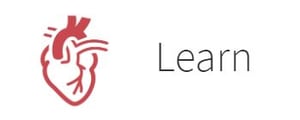
EKG Academy refers to the resources in the Learn category as “modules.” In total, they have 14 modules that include self-paced lesson presentations and multiple-choice questions.
These lessons teach students who have little to no experience with rhythm interpretation. They’re also good refreshers for someone who needs to brush up on the basics.
Practice
The Practice resources are the meat and potatoes of EKG Academy.
In this section you’ll find four options for practice:
- EKG Interpretation Practice Quiz
- EKG Interpretation Drill with Analysis
- EKG Interpretation Coach
- Graded Quizzes with Certificates
These resources are great because your students can pick and choose what they’ll learn based on where they need the most help.
Plus, the option to earn printable certificates for completing the graded quizzes is a great bonus!
Reference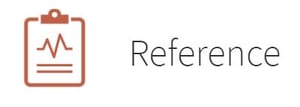
The Reference resources are reference guides for specific topics regarding rhythm analysis.
Here, you’ll find overviews of seven types of rhythms:
- Cardiac rhythms
- Sinus rhythms
- Atrial rhythms
- Junctional rhythms
- Ventricular rhythms
- Heart block rhythms
- Pacemaker rhythms
Each reference page includes a brief overview of the rhythm and its subtypes. You’ll see example images for each subtype, along with accompanying explanations.
In general, EKG Academy is an excellent resource that your students can use both in and out of the classroom!
The only downside to EKG Academy is the number of ads on each page. Some of them can be intrusive and obstruct the page content.
If you share this resource with your students, it’s smart to remind them to steer clear of the ads!
2. Practical Clinical Skills

Practical Clinical Skills is a medical education site that provides free training and reference materials for many types of healthcare skills.
One of their most popular categories is EKG, which has a number of different resources, including: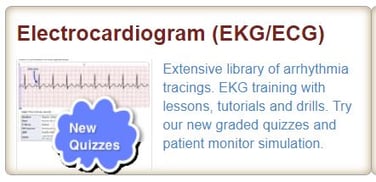
- EKG Basics course
- EKG practice drills
- An arrhythmia reference guide
- An EKG tracing quiz
- An EKG monitor simulation quiz
EKG Basics Course
The EKG Basics course is an 11-page introduction to the basics of EKG tracings and analysis. Each page includes graphics and detailed information on a specific EKG concept.
Along with the lesson information, students can answer related quiz questions to test their knowledge as the progress through the course.
EKG Practice Drills
The EKG Practice Drills are an interactive way for students to test their knowledge of arrhythmias. Students view an EKG tracing and answer a multiple-choice question.
If they answer a question incorrectly, they receive immediate feedback with an explanation of how to know the correct rhythm.
Arrhythmia Reference Guide
The Arrhythmia Reference Guide is an excellent resource for students to quickly review more than 30 rhythm variations.
When you click on a specific rhythm, you’ll see a detailed overview of its characteristics. This is a great way for students to get a quick reminder about items they may have missed the first time!
EKG Tracings Quiz
The EKG Tracings Quiz is a 20-question quiz that requires students to identify what they see on an EKG tracing strip.
Students can take the quiz multiple times and always have a fresh set of questions from a bank of 375!
If students register for free on the site, they’ll be able to save their scores and print a free certificate of achievement.
EKG Monitor Simulation Quiz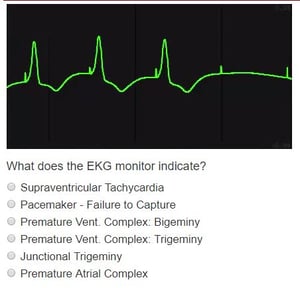
The EKG Monitor Simulation Quiz is similar to the tracings quiz, but actually has short video clips of an EKG monitor for students to view.
After completing the 20-question quiz, students see their graded score along with the static images that represent the simulations they saw in the quiz.
Overall, the EKG resources from Practical Clinical Skills provide plenty of options for your students to learn and review all types of EKG tracings.
Like EKG Academy, the only downside to the site is the use of ads.
However, they probably won’t interrupt your students’ concentration.
3. Life in the Fastlane

Life in the Fastlane has an “ECG Library” filled with resources to introduce the basics of EKG interpretation and practice identifying arrhythmias.
In the library you’ll find three types of resources:
- Pages on EKG Basics
- An A-Z list of interpretations
- A self-assessed quiz
EKG Basics
The EKG Basics section of the library includes more than 30 pages on topics like EKG waves, intervals, and segments.
Each page includes detailed information on each topic and a ton of diagrams that illustrate how certain items are depicted on tracings.
A-Z List of Interpretations
The A-Z List of Clinical Interpretations discusses potential diagnoses that can be made based on an EKG reading.
If you click on any term, you’ll go to a page that describes it, shows examples of a tracing, and even a brief history of the item.
Self-Assessed EKG Quiz
In terms of review and practice, the site has a series of 100 “cases” that include a clinical scenario and an accompanying image of a rhythm strip.
Students can describe and interpret the reading and then click to check their answer to see how they stack up.
On the downside, the quiz isn’t as user-friendly as the other options out there so students may not be as willing to do extra practice outside of the classroom.
In addition, it can be tough to find what you need. If you’d like to use this resource, it’s smart to share direct links to specific pages with your students, rather than having them locate it themselves.
However, the actual content is exceptionally detailed, so it could be the perfect supplement to the information in your lessons!
4. SkillStat
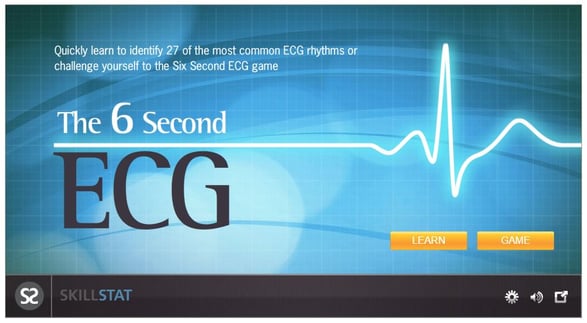
The SkillStat website is the most straight-forward EKG resource on our list. On it you’ll find one specific item -- their EKG simulator.
The simulator is designed to help students learn and identify 27 common rhythms and then test their knowledge in a game.
To accomplish this, the simulator has two distinct segments, which SkillStat calls Learn and Game.
In the Learn section, students can click on any rhythm to see it in the simulation and read a short blurb about it.
Then, once they feel comfortable in their knowledge of the rhythms, they can switch to the game and see how they do!
In the Game mode, students have 60 seconds to correctly identify as many rhythms as possible.
When the game starts, a rhythm is displayed in the simulator and the timer begins counting down.
Students get three chances to answer correctly before the game tells them the answer. Then students move on to the next question.
Once time is up, the game ends and students are shown their total score. If students need more practice, the screen shows an encouraging message telling them to “hang in there!”
Overall, the SkillStat EKG simulator is a fun way for students to learn to interpret EKG strips. You could use it as an in-class activity or as an extra resource for students to use at home.
Where to Go from Here with Your EKG Curriculum
So now that you’ve got some great resources for teaching your student so interpret EKGs, what’s next?
If your program wraps up with students taking the NHA CET certification, it’s going to take more than just some online resources to help you prepare them!
You’ll need to help them master other daily responsibilities that EKG technicians encounter, such as working with patients, transcribing notes, and more.
Not sure where to get started?
Click below to learn how to prepare your students for success on the NHA CET certification exam and their future careers!


